Tuesday Evening August 5, 2014
Robidoux RV Park
Gering, Nebraska
First we take the scenic drive to the top of Scott’s Bluff.
Although storm clouds are brewing, the haze of this morning is gone and I almost wish we had done the Saddle Rock Trail hike this evening instead for the clearer views. But we’ll drive up to the top so we’ll see the views from there just not from each level as we we did this morning. There are no turn outs on this drive unfortunately.
They close the gate to the drive up at 5:30. You have to be back down by 6:00 when the entire drive up and down is closed, at least to cars. We saw a group of bicyclists gathering around the gate for what looked like a trip to the top around 7:30 or so. It’s a pretty steep climb and by then the weather was seriously iffy.
Behind me I can see my favorite formation among Scotts Bluffs. It’s called The Dome. You can see it in the distance above and closer up below.
Tunnels are so much fun.
Tunnel number one.
Out the other side, we immediately see the second tunnel.
Out the other side.
Tunnel number three.
How did they do these tunnels and sheer cuts
Much better views this afternoon.
We reach the top where the views are much farther than they were this morning. We can see beyond the developed city of Scottsbluff.
But we want to see the Monument‘s undeveloped South side. We walk over to the South Overlook where we see the drive on the right and the trail we took this morning on the left.
We can see beyond Scotts Bluff to the Wild Cat hills in the distance.
David uses his binoculars to look for Winnona.
She’s beyond the red buildings, straight back from the middle of the roof of the second one. I get out my camera and by george, there she is.
Robidoux RV Park is a perfect location for visiting Scotts Bluff and other nearby natural attractions like Chimney Rock, Castle Rock, Steamboat Rock and several more which I wish I’d planned time to see. I had no idea there would be so much to do here. I didn’t know before we came that it was an important point on the Oregon Trail. We came because it was a National Monument on our way to Denver. The same story as Fort Robinson. I just love surprise discoveries. Can’t wait until I have no deadline to be somewhere so I can just drift along.
Recognize anything here?
We almost miss what’s happening just at our feet.
Down at our feet at the south overlook is a cute little rock wren flitting in and out of various holes in the rocks. We’re so busy looking at the improved views that we almost miss her antics.
In the distance, on the other side of Mitchell Pass, we can see the North Platte River which the trails were following. One on one side and one on the other.
The sky is beginning to look even more iffy.
We want to be able to walk the Oregon Trail so we know we’d better head back.
We can see the gate is not closed as we begin our descent.
Should have taken those kayaks off, they really interfere with the pictures.
As we pass through the gates, we notice the right hand gate is closed. No more going up today. We park the car and head over to the section of the Oregon Trail preserved here in Scotts Bluff National Monument.
It’s time to walk the Oregon Trail.
First a map reminder. Scotts Bluff is between Chimney Rock and Fort Laramie on this map. The Oregon Trail and the Pony Express are the green line on the south side of the river. The Blue line is the Mormon Trail on the North Side of the river and then veering south to Salt Lake City. The Gold Rush Gang followed the Oregon Trail and then veered down to Sacramento. Forget the Santa Fe Trail for now, it’s not part of this story. HA!
Scott’s Bluff, the dramatic series of clay and sandstone highlands surrounding us, is chiefly known as a landmark on the old Oregon Trail. Emigrants heading west encountered the bluffs after a 6 to 8 week trek across the monotonously flat grasslands.
The dome has the only blue sky above it this evening.
Through the 1840’s deep ravines near here forced early wagon trains to bypass this area. But in 1851 the military opened a wagon route and for more than a decade the Oregon Trail pioneers drove their teams and wagons through Mitchell Pass in front of us.
The path with the wagons on it leads to traces of the Old Oregon Trail. They were very clear as we walked but not so easy to see in the pictures.
David tries his hand at the Mormon Handcart. Many Mormons had no livestock or money to buy them or wagons and so they made the entire 1300 mile trip from Nauvoo to what would become Salt Lake City pulling their worldly goods in this little handcart. A typical handcart was three feet wide by four feet long. It had a shallow box about 9” high, wheels four feet tall and could carry an approximate load of several hundred pounds. Since carts were usually made entirely of wood, they were often noisy and subject to frequent breakdowns. I read that during a four year period from 1856 to 1860 over ten different handcart companies provided carts for approximately 3000 Mormons for the trail to Salt Lake City. He’s not putting much effort into it is he? And it’s even empty. Often two women would stand behind the bar and push as they walked along.
Between 250,000 and 500,000 people made their way west from 1841 to 1869. The covered wagon was one of the main methods of transportation, often drawn by oxen or mules. Wagons in the nineteenth century varied widely depending on what they were used for. The wagons utilized by the emigrants heading west also varied. They came from numerous locations and manufacturers. This makes it difficult to ascribe a generic label to an emigrant wagon; enough similarities existed to make comparisons. Among the manufacturers two stood our from the crowd, Murphy and Studebaker.
The wagons here are in absolutely pristine condition. No doubt the wagons did not look like this when they got to Scotts Bluff approximately 850 miles from St. Louis on their 2200 mile journey.
The first wagon we see is the Studebaker wagon at the back of the train. Yes they are the same brothers who eventually made the Studebaker car. They began their enterprise in South Bend, Indiana. As blacksmiths, they provided hardware for many of the early wagon manufacturers. Nearly every wagon making the journey westward had their components and spare parts. Within a few years of providing parts, they were making their own wagons. This beauty was purchased by the Monument in 2009.
Here are some of the details on this wagon.
The second wagon in the train is a Murphy Wagon. Joseph Murphy began producing wagons for the traders headed west from Missouri to Santa Fe and later for the overland emigration. His wagons became the best known on the western trails. Murphy’s wagons consisted of wheels, running gear, a box and a cover. They were usually nine feet high with a twelve foot long bed. The bed of a Murphy wagon had a straight box, unlike its more famous counterpart, the Conestoga,
which had a curved box. A Murphy could comfortably haul between 1,800 to 2,200 pounds. Straying too far from these specifications risked serious problems.
Oxen were most often used for pulling this type of wagon. It required at least two yoke of oxen, a yoke consisting of two oxen. A third yoke often trailed behind so the livestock could be rotated and rested.
For those who preferred mules, an equivalent number of yoke could have been used in place of oxen. Horses were rarely, if ever, used. They lacked the strength and endurance needed to pull a wagon 2,000 miles. They also required costly supplemental feed. This Murphy wagon was purchased from the Dewitts Buggy Works Company in 1979 and donated to the Monument by the Oregon Trail Museum Association
Probably Studebaker parts.
The head wagon had a dandy of a paint job. A true large Conestoga pulled by 6 oxen. The Conestoga wagon is the most familiar pioneer wagon to me since it seems to be the one used in films. Actually I find out this vehicle was the primary choice for freighting companies shipping goods to the western frontier. It is described as “sleek and angular with graceful curves, attractive to the eye.” I’ll have to agree, this is a beauty of a wagon.
Sometimes a medium sized variation of the Conestoga would be used by families traveling the Oregon Trail. The name Conestoga came from the Conestoga River Valley in Lancaster County, Pennsylvania. A Conestoga’s average size was 17 feet long and 11 feet high, reflecting the freighter’s need for space in hauling. In addition to a longer bed, it had a curved box much like that on a boat. This kept freight from moving and shifting, thus keeping the cargo in the center during transit.
This wagon required a double cover. The cover was usually made of canvas, cotton sailcloth or
homespun hemp. It angled out slightly more than that of a typical emigrant wagon to help protect
the cargo from the weather.
The front and rear gates angled up higher to help prevent freight from sliding out the back on steep inclines. A Conestoga could likely haul loads up to three tons. A load that size would have required eight or more yoke of oxen.
The Oregon Trail Museum Association purchased and donated this Conestoga wagon to the Monument. This is an exact replica of the one on display in the Smithsonian Institute in Washington, D.C. and was purchased in 1973 as the first of the wagons, from the Ozark Craftsman at Dollar City, Missouri.
Now about those oxen….
Even though six-mule teams were preferred for their speed, six out of every ten wagons were pulled by oxen. Mules were strong, quick and tolerated the heat better; but oxen on the other hand were good tempered, strong, could eat native grasses and were a lot cheaper.
This team of life-size fiberglass oxen was purchased to represent a likeness to the actual animals used during the migration along the Oregon Trail in the middle to late 1800’s.
Time to walk the trail.
We start out on a pathway going west and soon the path is running beside the trail which you can only see because of the raised sides where so many wagons, over so many years, wore down almost a trench. There is a marker at the point that you can see the original trail.
It runs between these two rocks
Here we can see the raised sides with the trail sign in the middle
Heading toward Mitchell Pass.
I wonder how many travelers here were also heading into storm clouds.
I imagine this is what weeks of their journey looked like. Prairie as far as you can see. The trail goes through that notch. A closer picture of it follows.
We are at the end of the hike when we hear the thunder. We look ahead and see that rain is falling on the other side of Mitchell Pass. Boy I’ll bet they would have hated to see that. A line of wagons alone on a flat prairie with lightning striking the ground. How many were injured or killed by lightning?
We turn around and head back in the direction of not quite so dark skies. I photograph the trail from this direction which is actually a bit easier to see although this is not the views those on the trail would have had since I am walking East. Unless they turned around to give it up and returned that is. But this far into the journey, I doubt it.
David has turned back before me deep in conversation with a man from the Netherlands visiting here. I cannot remember his name but he was well versed in American history and was appalled at our country’s treatment of the Native Americans citing specifics from letters about the genocide policies of Presidents Washington and Jefferson. He knew more facts than either one of us, for sure.
Back at the visitor center we see the bicycle group discussing their ride. It is beginning to rain at this point. It held off just long enough for us to get in the car. Thank you very much.
We’ll be heading out for Denver tomorrow.
This is the parting shot I took as we drove back to Winnona in the rain.


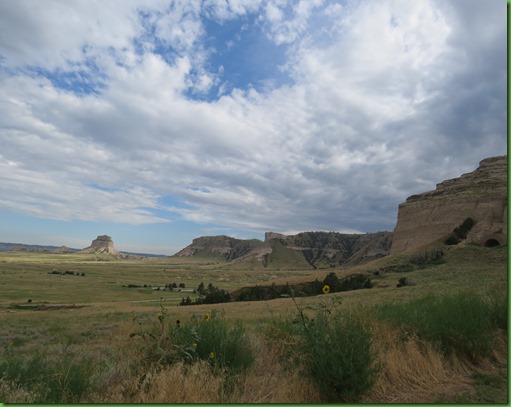















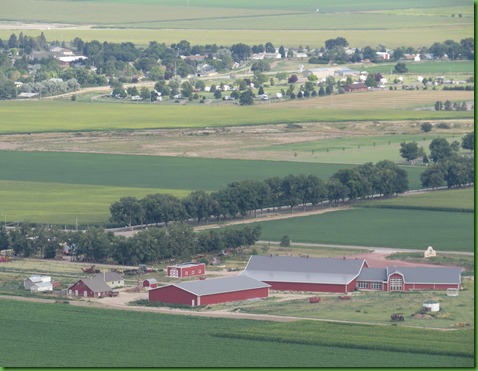






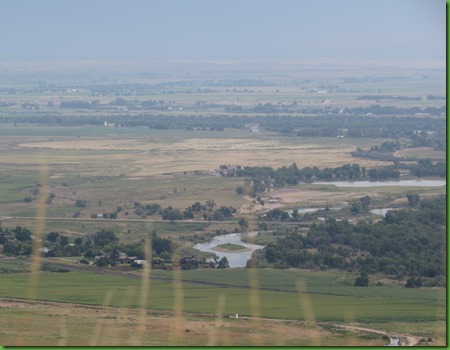




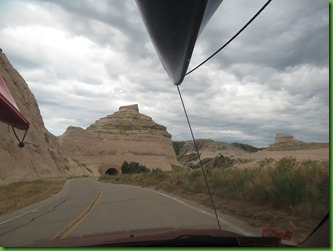














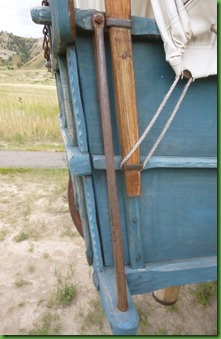
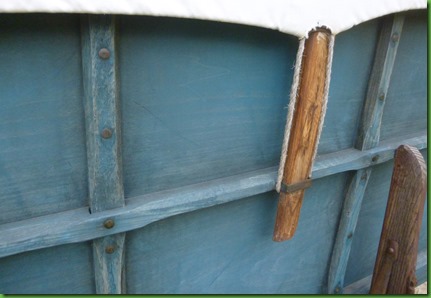




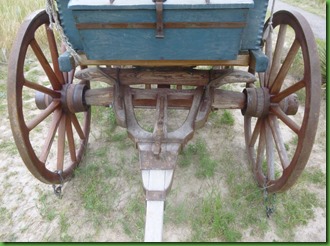









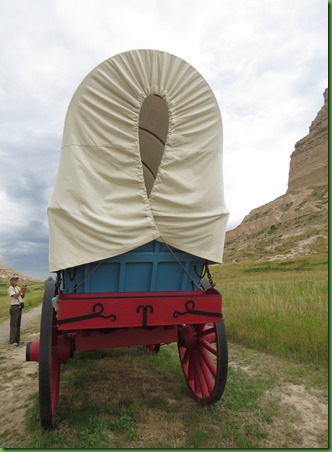








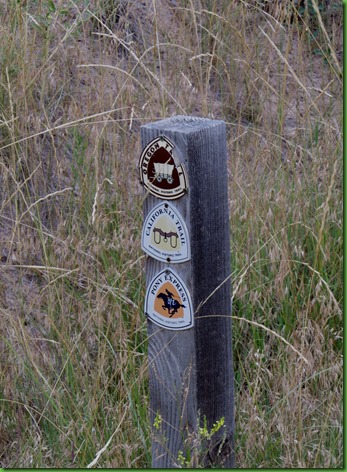











I like the part where the women pushed the wagon! I also wonder what would enter a mans mind to decide to make fiberglass oxen.(Giggle) The blog is great and the photos are phenomonal!
ReplyDeleteIt sure would have been tough pulling one of those handcarts, but it probably wasn't much better sitting in a wagon. You really have to admire the stamina and determination of people back in those days.
ReplyDeleteI think someone from the Netherlands coming to visit the U.S. and criticizing anything about our previous actions would be equivalent to an American going to Germany and criticizing the German people for the Nazis. While both may well deserve the criticism, it is a really rude thing to do. We know full well how awful our actions were, just as Germans and Nazi sympathizers throughout Europe knew theirs were.
ReplyDeleteAre the Conestoga wagons the first RV's?
You go girl! I agree with you! Beautiful pictures though!
DeleteGreat history and memories! Thanks:)
ReplyDeleteLoved your thoughts about finding unexpected surprises along the way. Some of our best travel memories include those out of the way discoveries we just happened upon. The Pony Express museum I've mentioned was one of those unplanned surprises. We were on our way from Lincoln, NE to Cheyenne, WY (bagging state capitals!!) and found the museum in a park in Gothenberg, NE where we'd stopped for lunch. Sure wish we'd had time to explore all the way to Scott's Bluff!! Did you all go through Cheyenne on your way to Denver? Cute little town and unique State Capital.
ReplyDeleteBeautiful, stunning photographs. I have not yet visited this place- haven't been in Nebraska, but I'd love to see the monument for myself.
ReplyDeleteGlad you got to walk the Oregon Trail!! You captured some wonderful views with that ominous sky. Wonder how the bikers made out?
ReplyDeleteThis time last year, while in Oregon, I purchased a book written about the women who walked and rode the Oregon Trail. It was taken from their journals and was so interesting. I was amazed at the tasks that the women performed. Pregnancies were never mentioned in the journals. Only when there was a birth or death of mother and / or child, would there be a notation in a journal.
ReplyDeleteI was there yet I still learned a lot from reading this great post. I find it fascinating to consider the realities of making this trip back in those days. They were some hardy people.
ReplyDeleteThe wagons are pretty amazing and I didn't know Studebaker was involved from my hometown!
ReplyDeleteDon't get too down about problems with Blogger, they crop up from time to time and drive me batty and then all of a sudden its fine again. I don't get it, but then again, I don't want to pay for Wordpress and they have issues as well. Its taking me awhile to catch up with your posts, but hang in there please because it is all so interesting and if you stop writing how will we know where you are?? :-)!!
ReplyDeleteHaving spent many years in Nebraska, Scottsbluff was familiar to me, but unfortunately, I never went there. That's certainly an amazing place with such interesting history.
ReplyDeleteI agree with Gypsy though. I am disgusted with our treatment of the Indians, and African Americans, but I don't like to hear someone from another country criticize us.
I'm not sure if I missed it, but what is that bucket hanging from many of the wagons?
Great post Sherry.
I love those wagons - can't imagine traveling that far in one 'back then' or even now though :) Thank you again for showing us all that beauty and open spaces - and, the sweet little bird!
ReplyDeleteMaggie
Terrific look at the wagons that were used to cross the country. Almost seems a shame to leave them exposed to the elements, they won't last for future generations to enjoy.
ReplyDeleteAmazing how the trail was worn into the ground and still exists today. I hope to see the trail one of these days with my own eyes. :c)
Interesting that some people take a foreigner's shock at mistreatment of indiginous peoples by our ancestors as "criticizing our country". They should be shocked, we as a country should spend more time in our schools teaching our citizens about the mistakes we have made in our past instead of glorifying our conquest of this land and its people. Sorry, mini rant. However, if more schoolchildren were taught about the horrible mistakes our forefathers made perhaps we'd be making less mistakes in governing our nation today. History has much to teach, especially if we don't focus only on the parts that we want to. I just finished reading "In the Garden of Beasts" by Erik Larson which tells the true tale of our American Ambassador to Germany during the rise of the Third Reich. He was a college history professor who saw the writing on the wall...but the politicians didn't want to listen and much tragedy could have been averted if Hitler had been opposed internationally early on, even as simply as by refusing to trade with them. I saw bring the criticism on, as long as they are open to discussing the mistakes in their own part of the world. (I would love to start that conversation!) Imagine what we could learn!
ReplyDeleteWould have liked to meet up with you in Colorado, but there was too much going on with family and now I will be working at the North Rim of the Grand Canyon starting tomorrow. I have done a lot of driving in the past week. I have seen jobs posted for this area, it looks like a great place to spend some time. Can you imagine traveling cross country in a covered wagon, are we spoiled with our modern RV's and electronics?
ReplyDeleteAbsolutely love those wagons, the first mobile homes. It was my 18 year old dream to take a wagon like that across country on those old trails.
ReplyDeleteI would love to ride on those wagons :)
ReplyDeleteYour adventure so far are all on our list. Hope we can really make it there next year. Beautiful place to experience and feel blessed to see all the beauty around us.
Yet another great post. Sherry
Another lovely place! Did I say that's on our bucket list? :)
ReplyDeletehere I sit in the co-pilots chair with the foot rest kicked out, traveling West on I-94. . .cannot imagine pulling a handcart all those thousands miles. . .WOW!
ReplyDeleteLove the wagons - oxen or mule? - diesel or gas? - seems we've been making power decisions for a very long time :-). The little wren is so sweet. I imagine very few hikers ever see her. Along with the marvelous history, there is such a sense of openness here. You capture it in a way that I just want to keep going!
ReplyDeleteIt was my understanding that the wagon was for the stuff, the people all walked along. I recall hearing about a tarp being hung under the wagon and the people as they walked along (10 miles a day?) gathered anything that would burn (sticks & dry buffalo dung) and put it in the tarp for the cooking fires.
ReplyDeleteI think of that when I'm driving a long stretch on one of the interstates that follow an old wagon trail...
You had to really want to be where you were going in those days.
This was a great post, thanks!
So interesting to see the different wagons -- I've always been amazed at the determination and fortitude of those who traveled cross-country in a covered wagon. Makes me remember yet again to be very grateful for our comfortable little trailer. Love the photo of the rock wren! They're one of my favorite birds.
ReplyDeleteNice parting picture. Those are very impressive replicas of the wagons. They actually look quite spacious inside. I imagine that was a very bumpy ride and even if they walked alongside that certainly was many many miles. How neat to be there and imagine what their experience was like.
ReplyDeleteEverything there just looks so big, so vast. I can't imagine trudging along for bajillions of miles dragging a cart with 100 pounds of all of my stuff. Phew!!!
ReplyDeletexxxooo